
Troll spoons or diving baits to limit out on big spring Spanish macks.
One of the regular oddities of the Cape Fear coast is a spring run of large Spanish mackerel along rocks just off the beach a few miles north of Cape Fear and the mouth of the Cape Fear River. While they occasionally show up around other bottom structure in the area in the same general time frame, the focal point is a rock outcropping off Fort Fisher. Sheepshead Rock, as it is shown on most charts, lies in approximately 25 feet of water just offshore of the N.C. Aquarium at Fort Fisher, but it has one peak that rises to within 10 feet of the surface.
There must be something special about this particular rock. Spanish will gather around most of the other rock outcroppings in the area later on, but they always arrive at Sheepshead Rock in April and are larger than other fish in the early run.
These aren’t all citation-size fish, but there usually are a few in the mix. Most run from 2 up to 4 pounds, but they arrive hungry — with an attitude — and are twice the size of the barely legal Spanish working up the beach.
This early showing begs to be fished, and one of the captains who lead clients every spring is Dennis Barbour of Island Tackle Fishing Charters. A Wilmington-area native who worked as a mate as a youngster, Barbour learned his lessons well, especially about this early run of big Spanish macks.
“I can’t remember ever hearing a reason why this early run of big Spanish comes up our beach, but I can remember planning for it while in my teens, and it’s still going strong a bunch of years later,” Barbour said. “When I was a kid, you could still get a small boat through Corncake Inlet, and there were three captains who fished this spring run from the Basin. I worked for Capt. Columbus Efird, and he taught me well. There weren’t limits back then, and we often came back with fish boxes filled to overflowing.
That early start and years of practice have allowed Barbour to develop techniques that work for him and catch fish for novice and experienced anglers alike. He fishes some during the winter but feels his season begins in April when the big macks arrive off Fort Fisher.
“On the charts, the rock that is the primary focus of this run is called Sheepshead Rock,” Barbour said. “It is a fairly large rock with a peak that runs for a ways diagonal to the beach. There is one spot on it that comes up to within 10 feet of the surface, and we always called it ‘High Rock.’ It rises so fast and so high that it is almost spooky watching it come up on the fish finder.”
Barbour said unless he sees birds or surface bait that leads him elsewhere, he usually begins the day right around the rock. Most of the time, he said there will be a school or two fairly close by, but sometimes they move up or down the rock outcropping a little and you have to find them.
Barbour said to always pay attention to the birds; they are in it to get their next meal and can see a lot more than you from above the water. If a flock of birds is hovering over an area and not diving, they can see fish that are deep and haven’t pushed baitfish to the surface. If birds are wheeling, diving and screeching, the fish have pushed the baitfish to the surface and are feeding.
Barbour prefers to fish a spread of four lines when targeting Spanish. The outside lines are on lighter rods deployed from the rod holders on the T-top of Barbour’s boat. These lines have a 3-ounce trolling sinker and are followed by a Clark Spoon or Drone Spoon. The remaining lines are on shorter, stand-up style 20- to 40-pound class rods and are fished from gunwale rod holders nearest the transom. These outfits are a little heavier to handle planers, and Barbour fishes them using No. 1 planers followed by Clark Spoons or Drone Spoons.
“For most early Spanish, I would tell you to use the 00 size Clark Spoons or Drone Spoons,” Barbour said. “That is correct closer to the beach where the Spanish are smaller, but the Spanish around High Rock are larger, and fall tactics work best for them. I move up to 0- or 1-size spoons, like we fish during the fall when the Spanish and the bait are larger.
“Spanish mackerel are the most leader-wary of all of the inshore/nearshore fish,” Barbour said. “They have excellent eyes and swim fast enough to get a good look at things. I use mono and fluorocarbon leaders. Mono usually works fine along the beach where the water is stirred up and visibility isn’t great. However, when you move off the beach a ways for these early, large Spanish, the water clears and the lower visibility of fluorocarbon helps put fish in the boat and makes it worth the extra expense. I use long leaders, too, and begin the day with 25 to 30 feet of 20- or 25-pound test.”
Spanish mackerel are fast fish that slice and dice through a school of baitfish. Barbour believes trolling at a speed fast enough to excite them is crucial and said he usually trolls somewhere between 6 and 7 knots — 1,400 RPM on his 24-foot bay boat. Another benefit of faster trolling speeds, he said, is covering more water and finding schools of fish that are moving around.
When unsure of trolling speeds, Barbour said to look for a charterboat in the area — if there is one — and match their speed. In the absence of a charterboat, look at the other boats in the area and match the speed of one that is catching a lot of fish. Most fishermen tend to troll on the slow side and speeding up a little is often the adjustment needed to catch more fish. According to Barbour, you won’t outrun a hungry Spanish that wants your lure.
Once a Spanish is hooked and reeled in to the point where the planer or trolling sinker is at the rod tip, there is still 20 to 30 feet of leader back to the fish. There are several ways to handle this leader and some are better than others.
Barbour begins by setting up the boat with a cooler on his swim platform. The fish go right into it and are never on the deck to slime it up and regurgitate their last meal, which Spanish are notorious for doing. Barbour prefers to bring the leader in hand-over-hand and allow what has already been gained to trail behind the boat. He said this keeps it off the deck so it isn’t stepped on, it doesn’t tangle, and if the fish is dropped or has to be released, the leader won’t snag on something and allow the fish to jerk free.
Once the leader is hand-lined to the last couple of feet, the fish is lifted and flipped into the cooler. More often than not, in just a few seconds the struggling fish has thrown the lure and unhooked itself and the lure can be put back out to catch another.
Kyle Lewis, who works for Barbour at Island Tackle and Hardware in Carolina Beach, echoes just about everything Barbour said about the early Spanish mackerel run except that he often uses Yo-Zuri Crystal Minnow diving lures instead of spoons behind trolling sinkers and planers.
“The Yo-Zuri lures come with either a large or a small lip,” Lewis said. “The lips make these lures dive on their own, and a trolling sinker or planer is not needed. They can also be fished using a shorter leader that allows reeling fish to the boat. The lures with smaller lips fish shallower, and the large-lip lures dive deeper. These lures also fish at slower speeds.”
Lewis grew up fishing with planers and spoons and knows how well they catch Spanish, but after several years working with tackle-shop customers, including many novice fishermen looking for the easiest way to troll for Spanish, he suggests trolling with the lipped lures as a simpler alternative.
DESTINATION INFORMATION
HOW TO GET THERE: Sheepshead Rock is offshore of Fort Fisher, south of Carolina Beach on Pleasure Island. Access is best via I-40 to WIlmington and US 421 or US 17 and US 421. The Carolina Beach area offers three public boat ramps: one of the ICW a quarter-mile north of the Snow’s Cut Bridge on US 421, one at Carolina Beach State park that accesses the ICW — it’s a fee ramp — and at Federal Point at the end of US 421 in Fort Fisher. The latter has better access to inshore waters as opposed to the ocean through Carolina Beach Inlet.
WHEN TO GO: Spanish mackerel usually arrive around Cape Fear in April and stay until October. An early run of big Spanish is common around large, rocky outcroppings in the ocean just off the beach. The big push of these big fish is from April, into early May. The bigger fish are usually gone by the end of May, leaving the 10- to 16-inch fish, which are around in full force.
EQUIPMENT PREFERENCES: Fishermen who troll Clark Spoons or drone spoons behind trolling sinkers or planers need to fish with medium-stout outfits. When using lipped, diving baits, lighter outfits can be used. Reels should be spooled with 20-pound test, which is more than strong enough for Spanish. Monofilament is the best bet, because it stretches enough to prevent hooks from being pulled. Use Nos. 1 or 0 spoons early in the run, going to the smaller 00 lures later on. Silver or gold are prime spoon colors, with silver/pink flash strip and silver/gold flash strip also productive. Leaders should be 25 to 30 feet long because Spanish have excellent eyesight and shy from wire leaders. Clear water requires fluorocarbon leaders in 20- to 25-pound test. Fishermen can get away with monofilament in stained water closer to the beach.
REGULATIONS: The daily creel limit on Spanish mackerel in North Carolina waters is 15, with a minimum size of 12 inches. Be able to tell the difference between a big Spanish mackerel and small king, as limits and size minimums for kings are much different.
GUIDES/FISHING INFO: Capt. Dennis Barbour, Island Tackle Fishing Charters, 910-470-5041 or www.islandtacklehardware.com; Tex’s Tackle and Bait, Wilmington, 910-791-1763 or http://www.texstackle.com/; Island Tackle and Hardware, Carolina Beach, 910-458-3049, http://www.islandtacklehardware.com/. See also Guides and Charters in Classifieds.
ACCOMMODATIONS: Pleasure Island Chamber of Commerce, 910-458-8434 or www.pleasureislandnc.org.
MAPS: Maps Unique, 910-458-9923, www.mapsunique.com; Capt. Segull’s Nautical Charts, 888-473-4855, www.captainsegullcharts.com; Sealake Fishing Guides, 800-411-0185, www.thegoodspots.com; GMCO’s Chartbook of North Carolina, 888-420-6277, www.gmcomaps.com, Nautical Publications, 800-326-3567, www.greasechart.com.

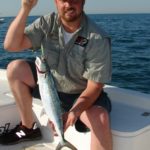
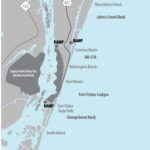
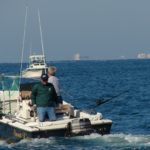
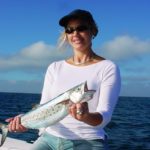

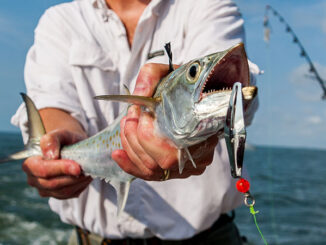


Be the first to comment